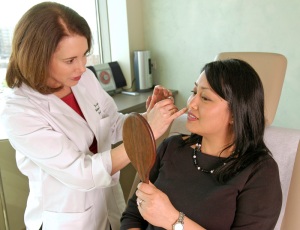When do I need to go to the dentist about my tooth pain?
If you experience persistent pain or you have a chipped or broken tooth, you may want to schedule a dentist appointment.
For many adults, the decision to make a dentist appointment can be difficult.
Being able to identify the source of your tooth pain and discomfort can help you make your decision. Some issues can be resolved by changing your daily routine, other issues cannot. Making this decision does not have to be difficult, however, with a little guidance you can avoid unnecessary tooth pain.
Causes of tooth pain
Tooth pain can be divided into two categories, pain caused by dental issues and pain caused by non-dental issues. For either category if the pain persists for more than a day or two, then it is a good idea to have it checked out by a dentist.
Dental causes
- Gum disease – gum disease, or periodontal disease, can cause the gums to become painful, red and swollen.
- Tooth decay – when bacteria gets a foothold on a tooth, it can cause the tooth to decay. Decay has various stages, the most minor being a cavity. Cavities are usually not painful unless they are allowed to progress significantly. If the decay is allowed to infect the pulp of the tooth it becomes abscessed, which is very painful.
- Damaged teeth – teeth can be damaged in a number of ways. If your tooth has been cracked, chipped, or broken it may become painful. Chipped teeth can also cut the cheeks and tongue if they are left sharp and untreated.
- Malocclusion – malocclusion is an uneven bite. Malocclusion can cause soreness both in teeth and in the jaw.

Symptoms of tooth pain
Pain is a major indicator that there is something wrong in your mouth. There are different types of pain associated with different dental conditions and issues. Pain can be sharp, dull, throbbing, or aching depending on the issue. Regardless of pain type, it is important to notify your dentist so that you can get the issue resolved.3
Common types of tooth pain
- Sensitivity hot or cold food or drink – if your teeth are sensitive to hot or cold food or drink for a short period of time it is likely nothing serious. If the pain lasts for half a minute or more, you may have a more serious issue in the pulp of a tooth.4
- Pain when biting down – a sharp pain that occurs while chewing or biting could mean that your tooth has been cracked or there is an issue deeper within the tooth. Loose fillings can also cause this type of pain.
- Puffy and painful red gums – if the gums are red, painful, and under pressure it could be a sign of an abscessed tooth. The infection has moved beyond the tooth and is now affecting the surrounding soft tissues as well.
- A dull aching pain – many times this is caused by clenching or grinding of the teeth also called bruxism. The pressure applied through grinding can cause jaw soreness and soreness in the tooth as well.

What happens if you don’t get a filling?
What happens if you don’t get a filling? When decay damages a tooth, the destruction to the enamel is irreversible. If the cavity is left untreated, the decay can spread and worsen, destroying healthy parts of the tooth. And if enough time goes by, your dentist won’t be able to repair the tooth with a conventional filling at all . . .
A ROOT CANAL
If the decay reaches the pulp chamber of the tooth, where the nerve and blood vessels are located, the bacteria will irritate and infect the pulp. Eventually, this may lead to an abscess, which is a swollen area of tissue containing an accumulation of pus (lovely, right?). Abscesses are typically very painful, and they can’t be repaired with a simple filling. At this point, your dentist will need to perform a root canal to save your tooth. The infected pulp will be removed, the inside of the tooth will be cleaned, and the tooth will be sealed. Often, the tooth must be covered with a crown as a final, protective step.
EXTRACTION
Given enough time, decay will wreak havoc on a tooth and may destroy it entirely. If this happens, a root canal won’t be able to save the tooth. Your dentist will need to extract the tooth and replace it with an implant or a bridge.

Treatments for Rotten Teeth
Rotten teeth can quickly progress to an infection, which can turn dangerous. If the decay hasn’t spread to the tooth pulp, your dentist can fill any cavities. However, if the pulp is affected, they can remove it in root canal work, then fill the tooth with a sterile dental material. When the cavity is so large it weakens the tooth structure, dentists often create an artificial covering called a crown that protects the rest of the tooth.
Alternatively, if a tooth is so badly decayed it can’t be saved and must be extracted, your dentist can replace it with a false tooth called an implant or a dental bridge. An entire set of upper or lower teeth can be replaced with implants or dentures. Your dentist can discuss the pros and cons of each option before you agree to treatment, but don’t wait before booking an appointment if your teeth are badly decayed. A tooth infection can quickly progress to a life-threatening condition called sepsis, warns the Sepsis Alliance. Sepsis is the body’s reaction to infection, and it causes fatigue and chronic pain, sometimes leading to amputations, organ failure and death.
The importance of fillings
A cavity will not heal on its own – it will only worsen. And as it worsens, the treatment options become more extensive and expensive. Root canals and crowns are not cheap treatments, and replacing a tooth is often even more costly. By treating a cavity with a simple filling early, you can save yourself money, pain, stress, and perhaps even a tooth!
A filling can restore a damaged tooth, returning its functionality and eliminating any pain. It’s an extremely common, routine procedure.
Your dentist will apply local anesthesia at the beginning of the appointment to numb your mouth and prevent discomfort. Then, the tooth decay will be removed from the tooth enamel using a drill. Your dentist will shape the space to prepare it for the filling. If a bonded filling is needed, your dentist will also etch the tooth with an acid gel to ensure the filling will securely attach to the tooth. After that, the resin filling will be applied in layers and hardened with a bright light, making it strong and sturdy. Finally, your dentist will polish the tooth and check your bite to ensure it’s comfortable.
Your dentist will decide which type of filling material is right for you based on the location of the filling, the extent of the repair, and the cost differences. If you have any concerns, don’t hesitate to discuss them with your dentist or hygienist.






